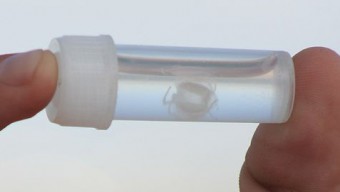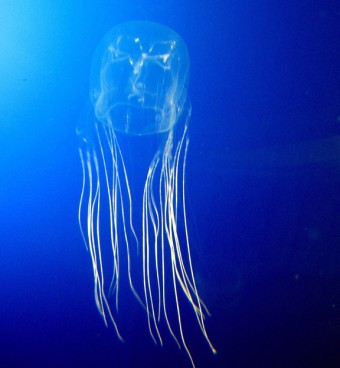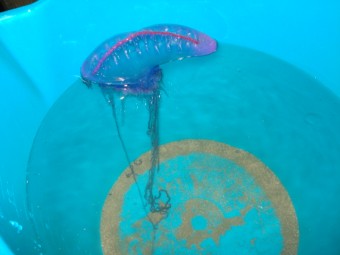How to Treat a Jellyfish Sting
 You should know how to treat a jellyfish sting.
You should know how to treat a jellyfish sting.
Contrary to popular belief, you should never urinate on a jellyfish sting. This will just make the problem worse, as does washing the sting with fresh water without prior treatment. You should also not try to put ice on it before properly treating the area, which is sometimes people’s initial inclination to try to take away some of the pain and swelling. If you put ice on it, what you’ll actually do is make it worse, which can be serious business in some cases, even causing death, depending on what you were stung by, the extent/location of the sting, and your age (elderly folk and children are much more susceptible to extreme reactions to jelly stings).
Before I get into how to treat a jellyfish sting, it’s first important to understand how jellyfish stings work. Jellyfish sting you through nematocysts which are released from their tentacles. Nematocysts are tiny spine covered tubules. The spines anchor themselves in your skin and when the nematocysts fire, various chemicals are injected into you. In some cases, you may have thousands of these nematocysts attached to your skin after coming in contact with a jellyfish tentacle, not all of which may fire right away.
When you pee on the sting or try to rinse it with fresh water this changes the tonicity, which in turn can cause the nematocysts to fire, injecting you with even more of the cocktail of chemicals, hence why you shouldn’t do this.

Irukandji are tiny jellyfish, usually not more than 1 cubic centimeter in size, that can be found in the ocean near Australia
While in most cases, jellyfish stings aren’t life threatening, they absolutely can be. If you happen to know your jellies and you know the sting is from an Irukandji or a box jellyfish, you’ll want to call for emergency medical aid right away. In extreme cases, box jellyfish stings have been known to kill people in a matter of minutes and anti-venom is needed to stave off the worst of the symptoms, so you’ll not want to wait around to see how the person’s body reacts first. Also, if the sting covers a large area, for instance more than half of an arm or a leg, or is on the face or genitals, it’s generally a good idea to call for emergency medical aid.

Box Jellyfish, not surprisingly can be recognized by its somewhat cubic shape, rather than domed. They also can move quite fast, as much as 5 mph, rather than just floating along as most jellies do.
In other cases, watch for signs of difficulty breathing, chest pain, difficulty swallowing, the person’s voice changing, loss of consciousness (easiest to spot!), hives, dizziness, irregular heartbeat or other heart symptoms, sudden weakness, nausea, or muscle spasms. If these signs start to pop up at all or if the person stung is a child or an elderly person, call for emergency medical aid right away.
So now that you’ve either called for medical aid or not depending on the severity of the sting or what did the stinging, how you should treat a jellyfish sting is, first, if a tentacle is still attached, you can choose to either try to remove it immediately or try to deactivate the nematocysts first using the method in the next step, making sure the person stung holds very still while either is being done. Some guides recommend removing the tentacle first and others say treat the area first. I’m inclined to go with the first as the tentacle can continue to impart additional nematocysts to the area the longer you’re attempting to treat it, which is particularly serious if you’re alone and having to move around and treat yourself, which will pretty well assure the tentacle will be releasing more nematocysts on you as you move.
To remove the tentacle, use gloves, thick clothing, tweezers, sticks, or the like to very gently detach it from the person being stung. Basically, just don’t touch the tentacle with your bare skin and try to minimize its movement on the skin of the person being stung. Also, keep in mind that the nematocysts can stick to your glove or clothing, so after removing the tentacle, you’ll want to throw away the item that came in contact with it to avoid accidentally stinging yourself later.
In order to deactivate the nematocysts, pour vinegar on the area stung for at least 30 seconds, and then, if possible, soak the area for as much as 30 minutes in vinegar. The acidity of vinegar should neutralize some or all of the unfired nematocysts, specifically neutralizing some of the proteins in the cocktail they shoot into you (though not all types of jelly stings use the same cocktail, so vinegar won’t always work).
Now, it should be noted here that you should not put vinegar directly in your eye, so if an eyeball was stung, instead use a saline solution, such as Artificial Tears, to thoroughly rinse the eye. If the sting is inside your mouth, gargle and swish around in your mouth a solution of 1 part vinegar to 3 parts water, then spit it out (don’t swallow!). Repeat this step a few times.
Also, if you were stung by a Man o’ War, vinegar will make their stings worse, so don’t use it in this case, instead, use the next solution.
If no vinegar is available, rinsing the sting in a baking soda / sea water (only if it’s salt water, no fresh water) mixture and then gently apply a baking soda / sea water paste to the area should also neutralize the nematocysts. If baking soda isn’t available, rinsing with sea water works too, just not as well.
Next, use a knife, shaving razor, credit card, etc. to very gently “shave” the area stung (don’t use very much pressure or it may cause any non-neutralized nematocysts to fire) to get rid of any remaining nematocysts. Some guides also recommend gently applying shaving cream or soap lather before shaving the nematocysts off.
Once you’re done shaving the area, re-apply the vinegar or salt water solutions.
Finally, dry the area off as best you can without using too much pressure. Taking an antihistamine, such as Benadryl, or applying a hydrocortisone cream to the area will help reduce itching and swelling.
In the aftermath, make sure to clean any open sores a few times per day with some type of antibiotic ointment. Most of the pain from the sting should begin to dissipate within 5-10 minutes of treating it and within 24 hours much of the pain should be gone. After the nematocysts are removed, ice-packs can help somewhat with the pain and swelling. However, don’t put the ice packs on before you’re quite sure you’ve gotten rid of the nematocysts.
If you liked this article, you might also enjoy our new popular podcast, The BrainFood Show (iTunes, Spotify, Google Play Music, Feed), as well as:
- Top Five First Aid Tricks Everyone Should Know According to a Paramedic
- CPR Does Not Require “Mouth to Mouth” and Actually Works Better Without It
- The Species of Jellyfish That Can Age Backwards
- The Difference Between Turtles, Tortoises, and Terrapins
Bonus Tips:
- It should also be noted that even after the jellyfish is dead they can discharge nematocysts, sometimes even days after the death of the jelly, which is why you should be careful playing with a dead jellyfish on a beach.
- If SCUBA diving around or underneath jellyfish, you can usually use your secondary air regulator to get rid of any jellies near or above you by releasing a blast of air at or underneath them.
- While not conclusive, recent studies have indicated that using hot sea water (between 104-113 F) to soak the stung area in, after rinsing with vinegar or baking soda / sea water mixture, not only should reduce your pain, but may also help decrease the effect of the venom, possibly even more so than a baking soda / sea water paste.
*Legal Disclaimer: While I am a crack researcher and an insatiable autodidact, I am not a doctor and more importantly I am not your doctor. This article contains general information about medical conditions and treatments. The information is not advice, and should not be treated as such. You should never delay seeking medical advice, disregard medical advice, or discontinue medical treatment because of information in this article…. There, I’ve covered myself.
| Share the Knowledge! |
|









I like your explanation. Yesterday at StoneSteps our local beach, my daughter was stung by a jellyfish (Encinitas CA, USA). The lifeguard (young woman, sorry forgot name) very competently treated Sasha by spraying with vinegar at the sting. Worked very fast & dramatic. However, she(the lifeguard) said that yesterday was the last day, that as of to-day, lifeguards are no longer allowed to treat jellyfish stings with vinegar? I thus came across your website. The committee which made the decision (San Diego County EMS) had many meetings; citing “evidence based studies and the American Heart Assoc.” they forbid Lifeguards from using vinegar. However, the AHA website specifically says, no question, use vinegar. I’m currently working to reverse their decision.
Mark
The reason the lifeguards are to stop using vinegar on jellyfish stings is because the chemical can sometimes make it worse and the nematocysts will fire more chemicals into your skin causing the stings to become worse. A jellyfish that reacts this way to vinegar is the Box jellyfish, a deadly jellyfish that lives off the coast of Austria, or some place close to it. Be careful when swimming with jellyfish because they could kill you.
– Katie
Austria has a coast now? Climate change is seriously out of control.
Between “sometimes make it worse” and experimentally, most of the time it works, I’ll take the second. Managing by the worst case is bad for most people.
My wife got stung by a jelly today at Myrtle Beach, and I ran out for vinegar after reading your article. Thankfully it was a minor sting with no lesions and no tentacles attached. After about 15 minutes, she has no more stinging. Thank you!
Just got stung by a jelly fish in cabo. Got treated with vinegar and feel much better. I’m glad that I did not use water or urine. Thanks for the useful information! The most comprehensive article I found
My wife got stung yesterday with 2 jelly fish in Texas. She was feeling the stings pretty bad across her legs at about 10:00 am. We were wade fishing, didnt know that jelly fish could sting you. It felt like ant bites over her body. We went to my truck where i used listerine to clean it. Then i went back into the water and grabbed a handfull of sandy bottom in saltwater and rubbed the area. I rerinsed with listerine. This stopped the stinging. By that evening the swelling and marks were gone.
Listerine is all i had in the truck a d it seemed to work. Old school listerine i might add.
Who the f*ck runs around on the beach all these ingredients except Rain Man? Vinegar? Shaving cream? I’ve been on my share of beaches, and all’s you need is gasoline (from the ATV or Waverunner) and, depending on the beach, the coarsest sand you can find to abrase the stinging cells off after they’re dead…this article went into WAY to much detail for an emergency situation, K.I.S.S. ( not the band)
In many beaches in tropical Australia, city councils stock their beaches with vinegar for this very reason. I sure as hell wouldn’t want you pouring gasoline on me if I’d been stung by a box jellyfish. And I bloody well wouldn’t want someone thinking they’re meant to pee on jellyfish stings when 10m up the beach there might be a bottle of vinegar for them to treat this very thing.
I was raised near the beach, and have always carried meat tenderizer with me in my beach bag. I have only had to use it once, but it worked like a charm. Sprinkle it on the sting liberally….it neutralizes the toxin. (thus stopping the sting!)
I got stung by what I think was a Jellyfish on Friday- medical aid sprayed vinegar on my hand but till today it is still itchy and feels very rough.
Visited the doctor as well, gave me Cutivate Cream and Fexofenadine pills. Also injected IV of antihistamine.
How long does it usually take for the rash on the skin to disappear caused by Jelly fish stings?
I was stung by a jellyfish in Hilton Head over a week ago. I had marks on both legs, where I was stung. Exactly a week after, my stings became inflamed and itchy. For those of you going through the itchy stage after being stung, use calamine lotion! It helped the itching tremendously.
Thank you for your help. My daughter and I were stung by jellyfish on Grand Turk, and the itching was severe for several days until we applied a paste of baking soda and water, then shaved this off and applied vinegar – instant relief! The redness faded after several weeks.
My husband got bit today in Orange Beach , we went to Dollar General and spent 1.00 on the hydrocortisone cream and within 2 hours his rash was completely gone as well as the itching. It worked Like a Charm !
I was stung by a clear/red baseball sized jellyfish in the Peconic Bay of New York (Eastern Long Island). This isn’t the normal season period for jellyfish, but raised water temperatures have made it possible for jellyfish to occur more frequently now (thanks, big business).
White vinegar does work, amazingly so. Even the cheap stuff (so buy yourself a gallon — you’ll need it). The sting went away within about 10~20 minutes. My arms felt like they were back to normal. You couldn’t tell that I had been stung. However… that was the deception. I figured the vinegar did the trick, but it did not stop what was about to come.
The next day I awoke to a rash on each arm, one much more extensive than the other. I tried vinegar again, but it did nothing — it’s only for the time shortly after being stung. I got myself some OTC 1% hydrocortisone cream. It helped relieve some of the itching, but didn’t do much to reduce the swelling of the rash… and the relief would be only temporary.
Calamine lotion is labeled for use from exposure to toxic plants like poison ivy, oak, sumac. Well, I guess it doesn’t entirely matter what triggered the body’s reaction — there’s an itchy rash and something is bound to relief the symptoms. The calamine lotion really helped. I applied some in one section and 1% hydrocortisone on another section. After 20 minutes it was clear that the calamine was more effective at reducing the rash swelling. I am intent to repeat application multiple times per day (wash, rinse, re-apply) as needed until this affliction has healed sufficiently enough where itching no longer occurs.
Simply amazing how a toxin from another creature can trick the body into such a problematic reaction. In essence, itching the affected site is EVERYTHING you want to do, and it’s absolutely WRONG to do it–it will only worsen the rash and either prolong it or make it a far more serious condition. And all the jellyfish wanted to do was immobilize me for possible extraction of nutrients.
I stepped on a dead jelly fish 6 months ago in North Carolina & did not know I was stung. . I still till this day have extreme joint , leg & foot pain & purple toes with red rashes up my leg . How can I get the ache to stop
4 days ago I was stung ( some type of jelly fish, not sure) in Ibiza, Spain , in various places, predominately around elbow and stomach. We made every mistake in the book in trying to clean and control the pain. It felt like razor blades cutting me when jellyfish stung. The tingling and numbness spread throughout my body. The doctor had to give me a shot, prednisone, antihistamine for days, along with a cream. Today, I can still see stingers in my skin and don’t know how to eliminate them . What is your recommendation?
I was stung by a jellyfish a little over two weeks ago. Up until 3-days ago, the rash/sore on my leg from the sting was still really bad. I was starting to worry that it was going to scar and take a long time to go away. I had been using hydra-cortisone on it everyday as mentioned in a lot of the remedies I found online, but did not see a difference. 3 nights ago I started applying neosporin (an antibiotic ointment.) The rash has significantly reduced and I truly feel that it will be gone in the next few days based on the progress I have seen so far. I don’t typically comment on these types of stories, but I searched the internet several times and I only found one article recommending an antibiotic ointment. I wish I would have been doing this sooner. Once the sore heals, I plan to use vitamin c serum to even out the discoloration from the sore. I’d recommend still using hydra-cortisone, but I’d couple it with the neosporin.
I agree with Kathy Cockrell. Meat tenderizer, mixed into a paste with sea water, will take the sting right out of there.